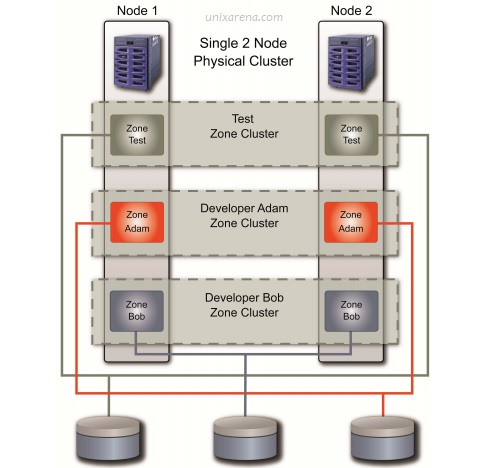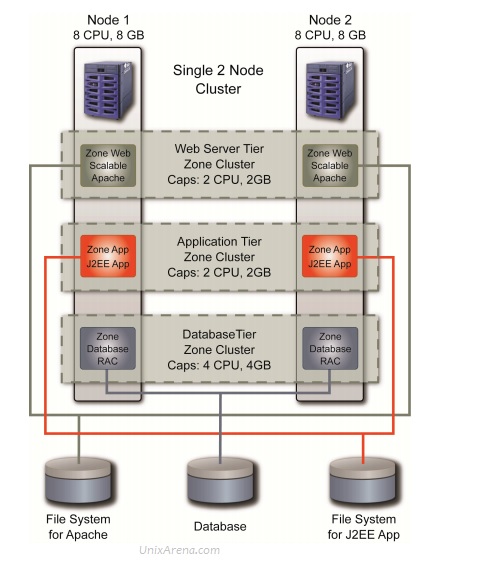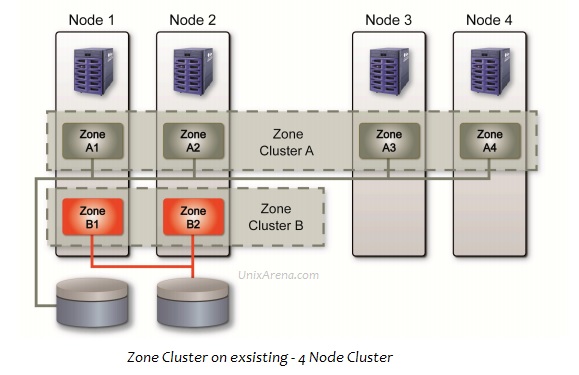This article explains about zone cluster. Zone cluster is created on oracle Solaris hosts using sun cluster aka Oracle Solaris cluster. In Most of the deployments , we might have seen the failover zones (HA Zones) using sun cluster or Veritas cluster (VCS) on Solaris. Comparatively , zone clusters are very less in the industry but used in some of the organization very effectively . You must establish the traditional cluster between physical nodes in an order to configure a zone cluster. Since cluster applications always run in a zone, the cluster node is always a zone.
The typical 4-Node Sun cluster looks like below. (Prior to configuring zone cluster )

After configuring zone cluster on global cluster,
zone cluster on global cluster
The above diagram shows that two zone clusters have been configured on global cluster.
- Global Cluster – 4 Node Cluster (Node 1, Node 2 , Node 3, Node 4 )
- Zone Cluster A – 4 Node Cluster (Zone A1 , A2 , A3 , A4)
- Zone Cluster B – 2 Node Cluster (Zone B1 , B2)
Zone Cluster Use Cases:
This section demonstrates the utility of zone clusters by examining a variety of use cases, including the following:
- Multiple organization consolidation
- Functional consolidation (See the below example)
Here you can see that both test and development systems are in different zone cluster but in same global cluster.

- Multiple-tier consolidation. (See the below example)
In this cluster model, all the three tiers are in same global cluster but are in different zone cluster.

- Cost containment
- Administrative workload reduction
Good to know:
Distribution of nodes: You can’t host multiple zones which are part same cluster on same host. Zones must be distributed across the physical nodes.
Node creation: You must create at least one zone cluster node at the time that you create the zone cluster. The name of the zone-cluster node must be unique within the zone cluster. The infrastructure automatically creates an underlying non-global zone on each host that supports the zone cluster. Each non-global zone is given the same zone name, which is derived from, and identical to, the name that you assign to the zone cluster when you create the cluster. For example, if you create a zone cluster that is named “uainfrazone”, the corresponding non-global zone name on each host that supports the zone cluster is also “uainfrazone”.
Cluster name: Each zone-cluster name must be unique throughout the cluster of machines that host the global cluster. The zone-cluster name cannot also be used by a non-global zone elsewhere in the cluster of machines, nor can the zone-cluster name be the same as that of a global-cluster node. You cannot use “all” or “global” as a zone-cluster name, because these are reserved names.
Public-network IP addresses: You can optionally assign a specific public-network IP address to each zone-cluster node.
Private hostnames: During creation of the zone cluster, a private hostname is automatically created for each node of the zone cluster, in the same way that hostnames are created in global clusters.
IP type:A zone cluster is created with the shared IP type. The exclusive IP type is not supported for zone clusters.
Hope this article is informative to you. In the next article, we will see that how to configure the zone cluster on existing two node sun cluster (global cluster).

Nick says
Nice article.
Thanks for sharing.